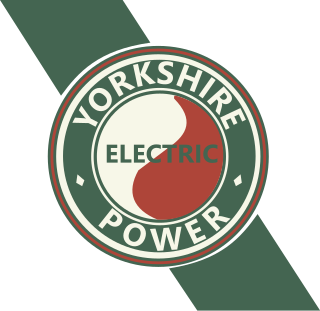Related Research Articles
The Central Electricity Generating Board (CEGB) was responsible for electricity generation, transmission and bulk sales in England and Wales from 1958 until privatisation of the electricity industry in the 1990s.

Northern Ireland Electricity Networks Limited (NIE Networks) is the electricity asset owner of the transmission and distribution infrastructure in Northern Ireland, established in 1993 when the business was privatised. NIE Networks does not generate or supply electricity. Since 2010 it has been a subsidiary of ESB Group.
The British Electricity Authority (BEA) was established as the central British electricity authority in 1948 under the nationalisation of Great Britain's electricity supply industry enacted by the Electricity Act 1947. The BEA was responsible for the generation, transmission and sale of electricity to area electricity boards, and the development and maintenance of an efficient, coordinated and economical system of electricity supply.
The South of Scotland Electricity Board (SSEB) generated, transmitted and distributed electricity throughout the south of Scotland, including the former regions of Strathclyde, Lothian, Fife, Central, Borders and Dumfries and Galloway and a few towns in northern England. It operated from 1955 to 1991.
The Lancashire Electric Power Company was one of the largest private electricity companies in the UK. It was established in 1900 and generated and supplied electricity to 1,200 squares miles of Lancashire from 1905 until its abolition under nationalisation in 1948.
Meaford Power Station was a coal-fired power station situated on the River Trent at Meaford near Stone in Staffordshire.

The Electricity (Supply) Act 1919 was an Act of the Parliament of the United Kingdom which amended the law with respect to the supply of electricity. It established the statutory body of the Electricity Commissioners ‘to promote, regulate and supervise the supply of electricity’ under the direction of the Board of Trade. It provided for the formation of electricity districts and, where necessary, the establishment of joint electricity authorities, ‘to provide or secure the provision of a cheap and abundant supply of electricity’.
Ribble Power Station was a coal-fired electricity generating station on the River Ribble in Penwortham near Preston, Lancashire, England. The station was built by the Corporation of Preston to replace a small privately-run generating station in the town. It supplied electricity to Preston and the surrounding area from 1923 until 1976. The station was expanded with new equipment in 1943–47 which remained in operation until the power station was closed in 1976 and was subsequently demolished.

The Electricity (Supply) Act 1922 was an Act of the Parliament of the United Kingdom which amended the law on the supply of electricity. This Act was construed as one with the Electricity (Supply) Acts 1882 to 1919, and was cited as the Electricity (Supply) Acts 1882 to 1922. It established the powers of electricity authorities to borrow money for the construction and operation of electricity generating and transmission systems; it amended some Sections of the Electricity (Supply) Act 1919 relating to electricity districts and joint electricity authorities; it empowered electricity authorities to provide a supply to railway companies; and established methods of reclaiming expenses of various statutory bodies.

The Yorkshire Electric Power Company was founded in 1901 to provide a supply of electricity to commercial and industrial users throughout the West Riding of Yorkshire, England. It built and operated power stations and constructed overhead electric power lines across an area of 1,800 square miles (4662 km2). The company’s power stations were at Thornhill, Barugh, Ferrybridge and Mexborough. The company promoted and stimulated demand for electric power and it was financially profitable for its shareholders. The Yorkshire Electric Power Company was dissolved in 1948 when the British electricity supply industry was nationalised. Its power stations were vested in the British Electricity Authority and its electricity distribution and sales functions were taken over by the Yorkshire Electricity Board.
Central Power House (Hanley) supplied electricity to the county borough and later city of Stoke-on-Trent, England and the surrounding area from the 10th April 1913 to the 1960s. The power station was initially owned and operated by Stoke-on-Trent Corporation, then by the North West Midlands Joint Electricity Authority prior to the nationalisation of the British electricity supply industry in 1948. The power station operated in conjunction with power stations at Burslem, Hanley (original smaller power station on the same site as the Central Power House), Stoke-upon-Trent and Longton.
Wolverhampton power station, also known as Commercial Road power station, supplied electricity to the Borough of Wolverhampton, England and the surrounding area from 1895 to 1976. It was redeveloped in several stages to meet growing demand for electricity: including the addition of new plant in 1902 to 1908, 1925 and 1942. The power station was initially owned and operated by Wolverhampton Corporation, but was transferred to the West Midlands Joint Electricity Authority in 1928. The British Electricity Authority assumed ownership at nationalisation in 1948. Wolverhampton power station was decommissioned in 1976.
Warrington power station supplied electricity to the town of Warrington, Lancashire and the surrounding area from about 1900 to 1979. The power station was initially developed by the Warrington and District Electric Light and Power Company Limited, this was taken over by Warrington Corporation, which operated the power station prior to the nationalisation of the British electricity supply industry in 1948. It was redeveloped several times to meet the increased demand for electricity.
The Shropshire, Worcestershire and Staffordshire Electric Power Company was an electricity generating and supply organisation that operated in the West Midlands and South Wales. It was established in 1903 and was dissolved as a consequence of the nationalisation of the British electricity supply industry in 1948.
The London and Home Counties Joint Electricity Authority was a United Kingdom statutory body established in 1925 with the responsibility to "provide or secure the provision of a cheap and abundant supply of electricity” within the County of London and parts of the surrounding home counties. The Authority acquired electricity in bulk from electricity undertakings for distribution, and operated some power stations in Surrey. The Authority was abolished upon nationalisation of the British electricity industry in 1948.
The West Midlands Joint Electricity Authority was a United Kingdom statutory body established in 1925 with the responsibility to "provide or secure the provision of a cheap and abundant supply of electricity” in the Midland counties of Shropshire, Staffordshire and Worcestershire. The Authority acquired electricity in bulk from electricity undertakings for distribution, and operated power stations. The Authority was abolished upon nationalisation of the British electricity industry in 1948.
The North West Midlands Joint Electricity Authority was a United Kingdom statutory body established in 1929 with the responsibility to "provide or secure the provision of a cheap and abundant supply of electricity” in parts of the Midland counties of Shropshire, Staffordshire and Cheshire. The Authority acquired electricity in bulk from electricity undertakings for distribution, and operated power stations. The Authority was abolished upon nationalisation of the British electricity industry in 1948.
The North Wales and South Cheshire Joint Electricity Authority supplied electricity to an extensive area of North Wales and parts of Cheshire and Shropshire. As constituted in 1923 the Joint Authority transferred all its rights to distribution of electricity in the area to the North Wales Power Company. The authority was effectively the power company. Both the joint authority and the power company were abolished in 1948 upon the nationalisation of the British electricity supply industry.
The British Power and Light Corporation Limited, also known as the British Power & Light Corporation (1929) Limited was registered in 1929 to acquire a controlling interest in electricity undertakings in North Wales; East Suffolk; South Somerset; Trent Valley and High Peak; West Hampshire; and Ringwood, Hampshire. The corporation operated for 19 years and was abolished upon the nationalisation of the British electricity supply industry in 1948.
References
- 1 2 3 4 5 6 Electricity Council (1987). Electricity Supply in the United Kingdom. London: Electricity Council. pp. 41–2, 44–5, 60–1. ISBN 085188105X.
- 1 2 3 4 5 Hannah, Leslie (1979). Electricity before Nationalisation. London: Macmillan. pp. 70–1, 83, 112. ISBN 0333220862.
- 1 2 3 Bloomfield, G. T. "British Electricity History" . Retrieved 28 October 2023.
- ↑ Robson, William A (2021). Public Enterprise: Developments in Social Ownership and Control in Great Britain. Hassell Street Press. ISBN 9781013829048.
- ↑ "North Wales Power Company Limited". The Times. 13 May 1924. p. 21.
- 1 2 3 Bloomfield, G T. "The Merseyside and North Wales Electricity Board Area" (PDF). Retrieved 28 October 2023.
- 1 2 London County Council (1939). London Statistics 1936-38 vol. 41. London: London County Council. p. 368.
- 1 2 D G Tucker Electricity generating stations for public supply in the West Midlands 1888-1977
- 1 2 "West Midlands Joint Electricity Authority". The Times. 15 June 1927. p. 21.
- 1 2 "The history of electricity supply in the area" . Retrieved 28 October 2023.
- 1 2 3 4 "The Midlands Electricity Board Area" (PDF). Retrieved 28 October 2023.